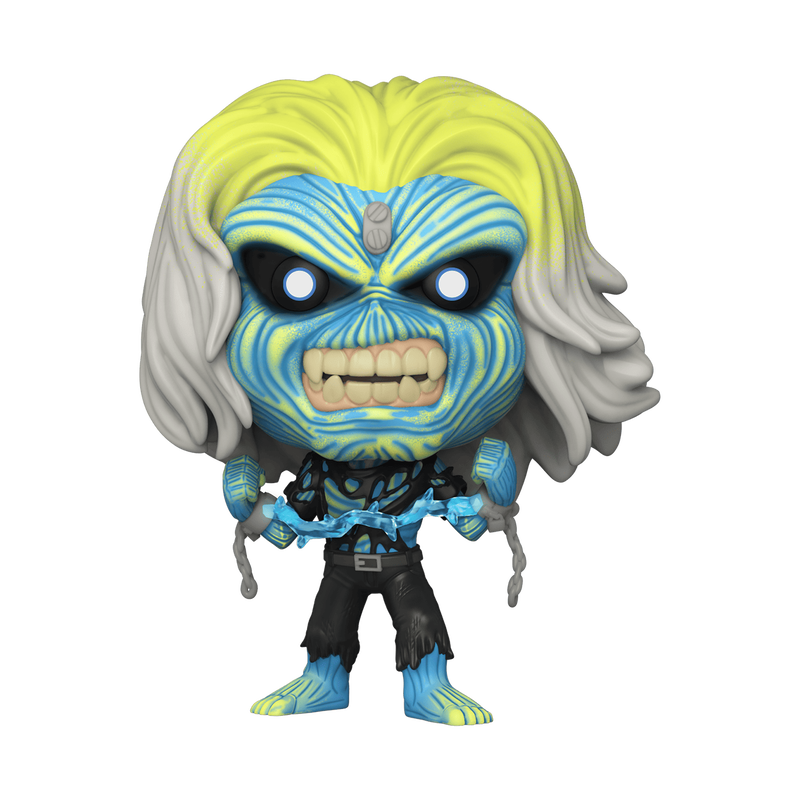Music
Who Is Eddie Iron Maiden? Unraveling the Iconic Mascot of Heavy Metal
Eddie the Head, more commonly known as just “Eddie,” isn’t simply a mascot; he’s a cultural phenomenon deeply intertwined with the identity of Iron Maiden and the very fabric of heavy metal music. This enigmatic figure, crafted from the dark imagination of artist Derek Riggs, has transcended the role of a band symbol to become a recognizable icon, a representation of rebellion, mortality, and the captivating world of heavy metal. His presence has permeated the genre, adorning album covers, stage backdrops, and merchandise across the globe, captivating fans with his grotesque beauty and ominous aura. But who exactly is Eddie, and how did he become such a ubiquitous symbol of heavy metal? This exploration delves into the origins, evolution, and enduring cultural significance of who is Eddie Iron Maiden, unraveling the intricate layers of this iconic character that has defined a generation of music lovers.
The Genesis of Eddie: From Grim Corpse to Multifaceted Icon
Iron Maiden’s debut album in 1980 marked the first appearance of Eddie, initially depicted as a grinning, gruesome corpse. This early portrayal laid the foundation for his unique aesthetic, one that combined macabre imagery with a sense of dark humor. However, the character quickly evolved beyond his initial grotesque form, undergoing transformations that paralleled the band’s musical journey and thematic explorations. Over the years, Eddie has been reimagined in countless guises, each iteration reflecting the specific narrative of an album or the broader cultural themes Iron Maiden sought to explore.
The Creative Vision of Derek Riggs

The birth of Eddie is intrinsically linked to the artistic vision of Derek Riggs. Derek’s unique style, characterized by a blend of horror, fantasy, and a dark, almost comical aesthetic, perfectly captured the spirit of Iron Maiden’s music. The early designs, with their focus on a gruesome character embodying death and destruction, were not merely illustrations; they were narrative components, offering glimpses into the dark and fantastical worlds envisioned for each album. While Eddie’s appearance has changed over time, the fundamental essence of Riggs’s original design remains, providing a cohesive thread that connects the character’s multiple incarnations.
Derek Riggs wasn’t just an artist; he was a storyteller. He understood that Eddie was more than just a drawing on an album cover; he was a character that could be developed and evolve. He viewed each album cover as a canvas where he could explore different aspects of Eddie’s personality. For instance, while the original design portrayed Eddie as a grim reaper type of ghoul, later iterations introduced new dimensions to his persona, showcasing his adaptability to diverse themes.
A Character in Constant Transformation
Eddie is not confined to a singular identity; he is a chameleon, adapting to the narrative of each album and the changing landscape of heavy metal. His ability to embody various roles—from a World War II pilot to a pharaoh to a cyborg—has allowed him to become a symbol of the band’s versatility and their exploration of different subjects throughout their vast discography. This evolution mirrors the ever-changing nature of Heavy Metal, with its diverse subgenres and themes.
The constant reinvention of Eddie can also be seen as a reflection of Iron Maiden’s own musical growth and their penchant for venturing into new sonic territories. It showcases the band’s understanding that music isn’t static but rather a fluid form of expression capable of adapting to the times and embracing diverse influences. As the music evolved, so too did Eddie, embodying the evolution of Iron Maiden’s sound and lyrical themes. This constant adaptability has cemented Eddie’s status as a truly unique and enduring icon.
Eddie as a Cultural Commentary
Eddie’s ability to mirror the themes explored in Iron Maiden’s music makes him a fascinating tool for cultural commentary. His appearance can be interpreted as a dark reflection of societal anxieties, fears, and historical events. This element, intertwined with dark humor, creates a unique and engaging experience for the fanbase. The evolution of Eddie also acts as a mirror to society’s shifting anxieties and concerns.
In the 1980’s, societal anxieties surrounding nuclear conflict and war were reflected in Eddie’s portrayal on “The Number of the Beast” and “Piece of Mind”. When social anxieties shifted, Eddie followed suit, mirroring themes of historical events and mythology within the albums, resulting in different iterations like the ancient Egyptian motif in “Powerslave” or the futuristic space marine in “Somewhere in Time” demonstrating the adaptability of the character to changing societal anxieties and themes. This adaptability and capacity for reflection make him a potent symbol of how music can engage with and reflect a broader cultural context.
Eddie and the Fabric of Heavy Metal: Beyond Album Covers

Eddie’s impact extends far beyond the covers of Iron Maiden albums; he is intrinsically linked to the fabric of heavy metal itself. His presence has permeated the genre, becoming not just a mascot but a symbol of the subculture and its values. This permeation is witnessed through Eddie’s appearances at concerts, his presence on merchandise, and his influence on other artists within the genre.
The Stage Presence of Eddie
Eddie’s presence at concerts isn’t merely decorative; it is an integral part of the Iron Maiden live experience. His colossal, often animated, depictions serve as a testament to the band’s dedication to creating a theatrical experience for their fanbase. The inclusion of Eddie on stage makes each concert a memorable and immersive event.
Beyond simply being a visual element, Eddie’s stage presence has become a symbol of the band’s dedication to creating a truly theatrical experience for their fans. The iconic imagery of a massive inflatable Eddie towering over the crowd, spitting fire, or engaging in other fantastical displays has become synonymous with the intensity and spectacle of an Iron Maiden concert. He has become more than just a mascot; he’s a part of the show, a vital character participating in the narrative and adding a layer of theatrical spectacle to the band’s shows.
Merchandise and the Subculture of Iron Maiden
Eddie’s image is prolifically displayed on a wide range of merchandise, from T-shirts and posters to action figures and even pinball machines. This expansive merchandise landscape effectively illustrates how Eddie has transcended his role as a band mascot and become a symbol of a lifestyle embraced by millions of fans around the world.
He has become a badge of honor, representing a shared identity among fans. By wearing an Eddie t-shirt or owning an Eddie figurine, an individual signals their affiliation with a wider community, with heavy metal as a whole. It’s about more than just liking the music; it’s about identifying with a shared aesthetic and cultural ethos.
Eddie’s Influence on Other Artists
The impact of Eddie can also be observed in the work of other artists within the heavy metal genre. Many bands have drawn inspiration from Iron Maiden’s use of Eddie and have incorporated similar mascot-driven imagery into their own branding and visual aesthetics.
The influence of Eddie has become far-reaching within the broader heavy metal community. Many bands have adopted similar mascot-driven approaches to their imagery, drawing clear inspiration from Iron Maiden and Eddie’s significance. This can be seen in various bands utilizing distinct mascots or characters that help communicate their musical identity in a visual realm, contributing to a heightened visual aspect to the heavy metal genre. The legacy of Eddie, therefore, extends across the genre, serving as a foundational example of how a potent visual element can help define a band’s identity within the landscape of music.
Eddie and the Fanbase: A Shared Narrative and Identity

Eddie’s enduring appeal stems from his capacity to resonate with fans on a profound level. He acts as a focal point for shared narratives and a symbol around which a passionate and diverse community has formed. This intricate interplay between Eddie and the fanbase allows fans to actively participate in building the character’s legacy.
Eddie as a Canvas for Fan Narratives
The evolving persona of Eddie has encouraged a rich tapestry of fan interpretation. Each iteration of the character generates discussion and interpretation amongst the fanbase, providing a platform for fans to infuse their own narratives into its identity.
The fans’ active participation in building upon Eddie’s narrative has played a crucial role in making him more than just a symbol; he has become a living, breathing character in the minds of the fanbase. Fans create their own stories around Eddie, their perception of him influenced by different album covers and concerts or their understanding of the broader narrative built around the band and its lyrics. The fluidity of Eddie’s identity and his ever-changing appearance offer a unique canvas for fans to build imaginative stories around him.
A Shared Identity through a Collective Fandom
The fandom surrounding Iron Maiden and Eddie has fostered a sense of community and belonging amongst fans across diverse backgrounds. They gravitate around a shared love for the band’s music and Eddie’s compelling figure. This communal experience helps maintain the relevance of both the band and the character, particularly in an ever-changing musical landscape.
Eddie, therefore, acts as a significant unifying aspect within the fanbase. Fans of Iron Maiden from all over the world connect over their shared appreciation for both the band’s music and the singular importance that Eddie holds within their collective culture. Eddie’s persona has extended beyond the band itself, becoming a symbol of the enduring vitality of heavy metal culture. His ability to unite such a vast and disparate group of music fans speaks to the power of music and iconic imagery to transcend geographical boundaries and cultures.
Shaping Fan Identities through Eddie
Eddie’s role transcends mere mascot status; he has a profound impact on the individual identities of fans. His multifaceted nature allows individuals to project their own values, experiences, and emotions onto this visually arresting and symbolically charged character.
While Eddie, on the surface, may be depicted as a grotesque figure, he also holds a significant place within the hearts and minds of the fanbase. His image becomes imbued with elements of the fans’ individual identities. Fans may see themselves within Eddie’s rebellious nature, his confrontation with mortality, and the fantastical worlds he embodies. The ability for fans to attach personal narratives to Eddie demonstrates the profound relationship between iconography and individual identity in the realm of popular culture.
Conclusion: The Enduring Legacy of Eddie the Head

Who is Eddie Iron Maiden? The answer, ultimately, is multifaceted. He is a constantly evolving character whose visual presence mirrors Iron Maiden’s diverse musical landscape. He is a symbol of heavy metal’s rebellious spirit and unique aesthetics, a potent reminder of mortality and the darkly humorous side of dealing with life’s complexities. He is a representation of the shared experience and identity of Iron Maiden’s global fanbase, a testament to the power of music and imagery to create a strong sense of collective identity. Even if Iron Maiden one day decides to retire, Eddie’s legacy will endure, continuing to serve as a symbolic beacon for the subculture he helped shape. He is a constant reminder of the legacy of a band that pushed the boundaries of heavy metal, creating a cultural phenomenon that resonates with fans across generations. The enduring question “who is Eddie?” will continue to be answered through the lens of each individual fan, creating a rich tapestry of personal meanings and a vibrant collective identity for all fans. He is, indeed, more than just a mascot; he’s a symbol of an era, a movement, a genre, and a community whose grip on the heavy metal landscape continues to captivate and inspire.
